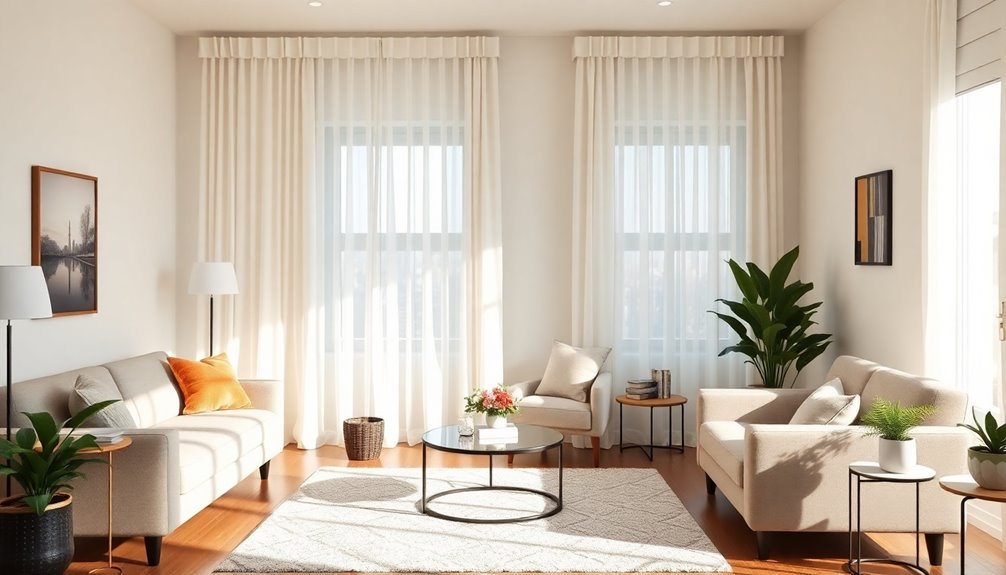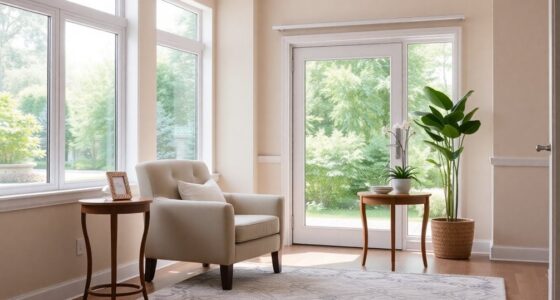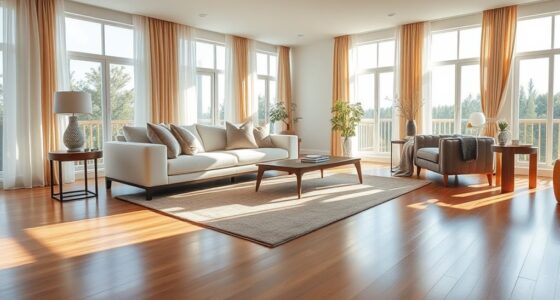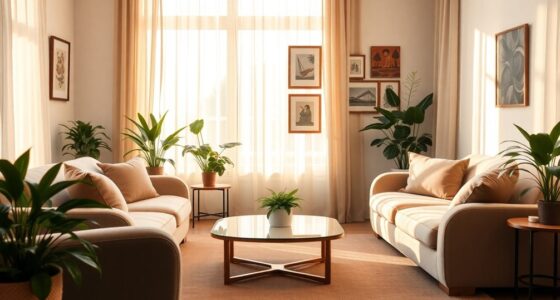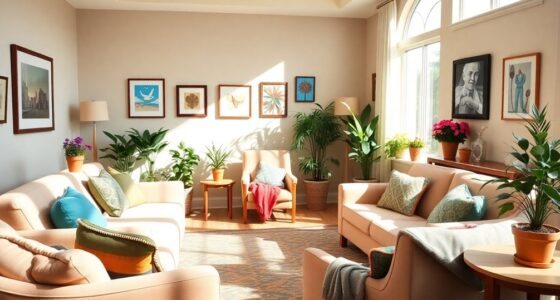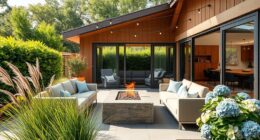To create a home ideal for aging in place, embrace an open floor plan and prioritize non-slip flooring to enhance safety. Optimize lighting for better visibility and install grab bars in key areas like the bathroom. Utilize adjustable furniture for comfort and incorporate smart home technology for added convenience. Finally, guarantee your kitchen and bathroom designs promote accessibility. With these tricks, you can create a welcoming environment that supports independence and safety, and there's much more to explore!
Key Takeaways
- Embrace an open floor plan with wide doorways and clear pathways to enhance mobility and reduce clutter for seniors.
- Prioritize non-slip flooring materials and clearly marked changes in flooring to minimize slip and fall risks.
- Optimize lighting with warm LED fixtures and smart technology for improved visibility and safe navigation.
- Install grab bars in critical areas like bathrooms and hallways to provide essential support and stability.
- Create an accessible kitchen with ergonomic workstations and easy-to-reach storage solutions to promote independence during meal preparation.
Embrace an Open Floor Plan

When you embrace an open floor plan, you not only create a spacious feel but also enhance mobility for seniors. This design minimizes obstacles, allowing easier navigation and reducing the risk of falls.
Wider doorways, at least 36 inches, guarantee accessibility for those using walkers or wheelchairs, making it easier for everyone to move freely. Removing unnecessary walls increases natural light in your living spaces, improving visibility and reducing eye strain.
Large windows further enhance this effect, providing better depth perception and a welcoming atmosphere. By designing open spaces with clear pathways, you reduce clutter and enhance safety, allowing seniors to engage in daily activities with confidence and ease.
Prioritize Non-Slip Flooring
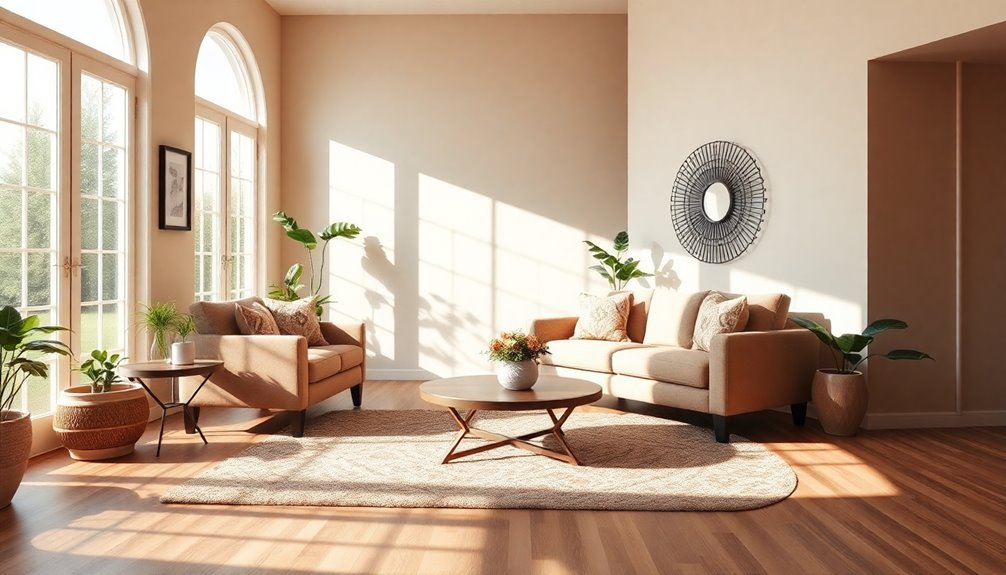
An open floor plan enhances mobility and creates a welcoming atmosphere, but prioritizing non-slip flooring takes safety to the next level.
Choosing materials like rubber or textured vinyl can greatly reduce the risk of slips and falls, common hazards for seniors. If you have existing floors, consider installing non-slip treatments to enhance surface grip.
Smooth, level surfaces minimize trip hazards, and clearly marked changes between different flooring types aid visibility. Avoid shiny surfaces and bold patterns to help improve depth perception, which is especially important for those with visual impairments.
Additionally, using contrasting colors at thresholds can alert you to alterations in flooring levels, further reducing the risk of falls. Implementing energy efficiency strategies can also contribute to a safer and more comfortable living environment as you age in place.
Optimize Lighting for Visibility
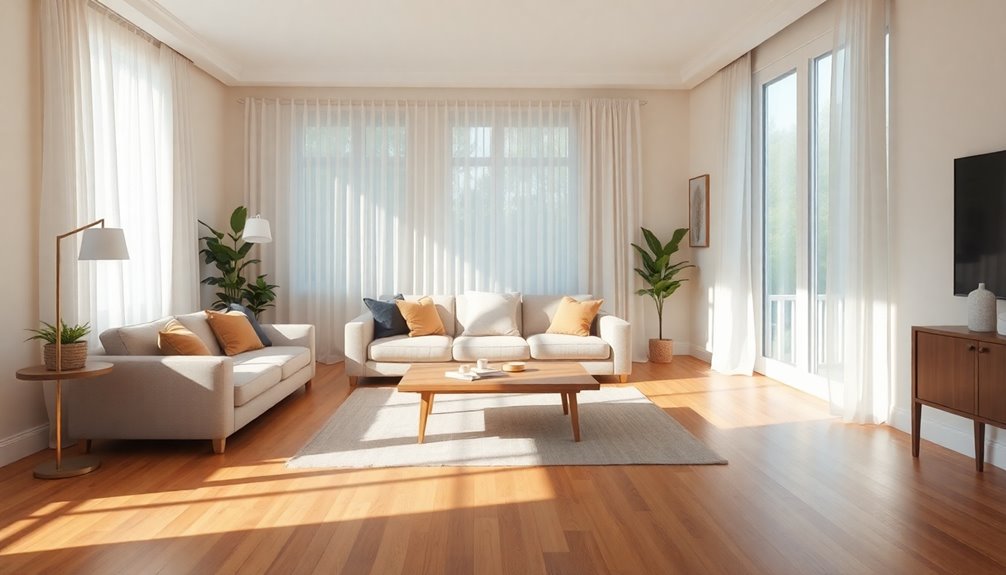
When optimizing lighting for visibility, consider using indirect lighting solutions to reduce glare and shadows, making navigation safer for seniors. Smart lighting integration can also enhance convenience, allowing you to control lights easily from multiple points. Additionally, ensuring that your home has energy-efficient models can contribute to lower electricity costs, further promoting a comfortable living environment. Together, these strategies create a well-lit environment that promotes safety and comfort at home.
Indirect Lighting Solutions
To create a safe and inviting home for seniors, optimizing lighting with indirect solutions is essential. Indirect lighting reduces glare and shadows, enhancing visibility and helping prevent trip hazards, especially for those with vision impairments.
Utilizing LED fixtures not only boosts energy efficiency but also means fewer bulb changes, making maintenance a breeze. Aim for a color temperature between 2,700 and 3,000 Kelvin, as this warm light is easier on the eyes.
Strategically place lamps in important areas like hallways and near seating to improve safety while maneuvering. Additionally, incorporating two-way switches in bedrooms and hallways allows seniors to control lighting from multiple locations, further enhancing safety and convenience in their daily routines. Furthermore, consider using air purifiers to improve indoor air quality, which can also contribute to a healthier living environment for seniors.
Smart Lighting Integration
Indirect lighting solutions set the stage for improved safety by minimizing glare and shadows, but adding smart lighting integration takes visibility to the next level.
In senior living, you can enhance your home's safety and comfort by utilizing smart lighting that allows you to control brightness with voice commands or smartphone apps.
Opt for LED fixtures with a color temperature between 2,700 and 3,000 Kelvin, ensuring a warm, inviting atmosphere while providing clear illumination.
Strategically placing lamps near stairways and entryways will considerably improve your visibility, reducing trip hazards.
With smart lighting, you'll not only navigate your home safely but also create a comfortable environment that adapts to your needs, making aging in place a truly enjoyable experience.
Install Grab Bars in Key Areas
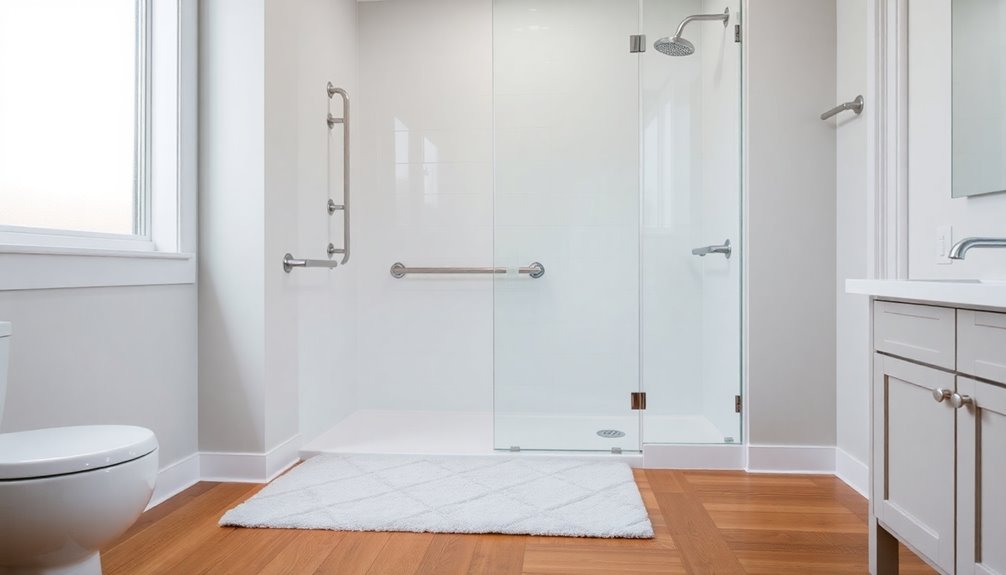
Installing grab bars in key areas like bathrooms and hallways can greatly enhance your safety at home.
You can choose from various types, including straight and folding models, to suit your specific needs.
Plus, the easy installation process means you can quickly add this essential support without major renovations.
Placement for Optimal Support
Though many overlook them, grab bars are vital for enhancing safety in your home, especially as you age. The placement for ideal support is important; install grab bars in bathrooms near toilets and in showers to greatly reduce the risk of slips and falls.
Aim for a height of 33 to 36 inches from the floor to maximize their effectiveness during changes. Make sure that they're anchored securely to wall studs or reinforced surfaces to support your weight when needed.
Also, consider adding grab bars in hallways and near staircases for additional stability. By incorporating these simple yet impactful features, you're creating an effective Aging in Place Design that prioritizes safety and independence in your daily life. Additionally, consulting with financial planning experts can help ensure that your home modifications fit within your budget.
Various Types Available
When considering grab bars for your home, it's essential to explore the various types available to suit your specific needs.
These vital home modifications can make your space safe and accessible for seniors. Here are three common types of grab bars:
- Straight Grab Bars – Ideal for stability in bathrooms or hallways, providing a sturdy hold.
- Curved Grab Bars – Designed for areas like showers, offering a secure grip at different angles.
- Folding Grab Bars – Perfect for smaller spaces, they can be tucked away when not in use, maintaining a clean aesthetic.
Selecting the right grab bars not only enhances safety but can also seamlessly blend with your home decor, ensuring both functionality and style. Additionally, ensuring a safe sleep environment is crucial for overall health and well-being, particularly for seniors who may have mobility challenges.
Easy Installation Process
To guarantee safety in key areas of your home, installing grab bars is a straightforward process that can greatly reduce the risk of slips and falls.
Focus on high-risk areas like bathrooms and hallways, where stability is essential. Start by securing grab bars to wall studs using appropriate anchors, making certain they can support at least 250 pounds of force.
You'll find various styles and lengths to suit both your functional needs and aesthetic preferences. Placing grab bars near toilets, showers, and bathtubs enhances safety during transfers.
Additionally, effective ventilation is crucial in bathrooms to help prevent moisture buildup, contributing to a safer environment.
For ideal placement and installation, consider consulting a Certified Aging in Place Specialist. They can make certain your grab bars are positioned correctly to create a safe and supportive environment for all.
Utilize Adjustable Furniture
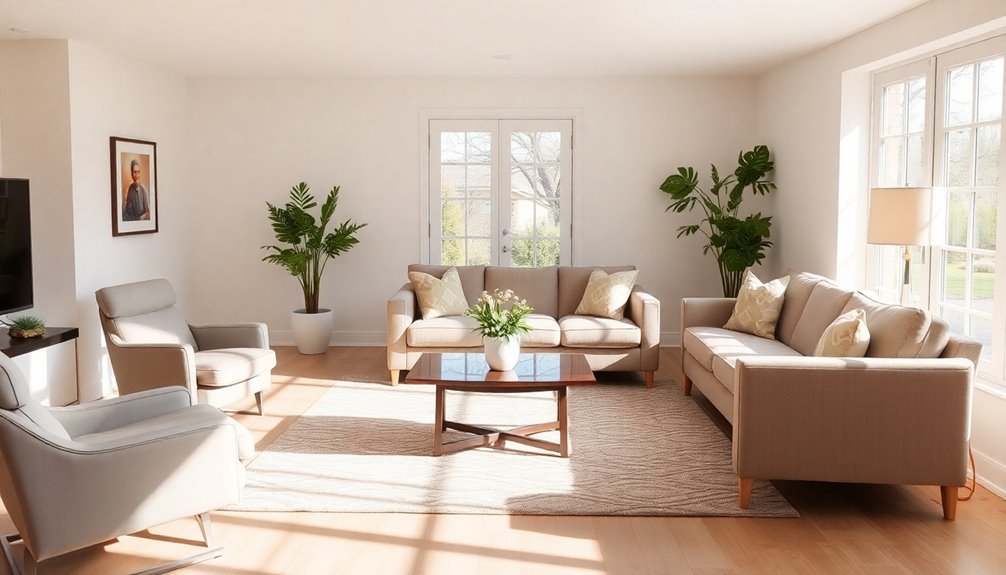
Adjustable furniture plays an essential role in creating a comfortable and accessible living space for seniors. This type of furniture adapts to varying mobility needs, making daily activities easier.
Here are three key pieces to evaluate:
- Adjustable beds: These allow you to find the most comfortable sleeping position, reducing strain on your joints and improving sleep quality.
- Adjustable shelving: This can help you reach items without bending or stretching, minimizing the risk of falls.
- Ergonomic recliners: With adjustable features, these provide lumbar support and facilitate safe entry and exit.
Incorporating these pieces not only enhances comfort but also promotes independence, making your home a safer environment as you age in place. Additionally, ensuring proper indoor air quality through regular maintenance of heat pumps can further enhance the living experience by filtering allergens and pollutants.
Create Clutter-Free Pathways
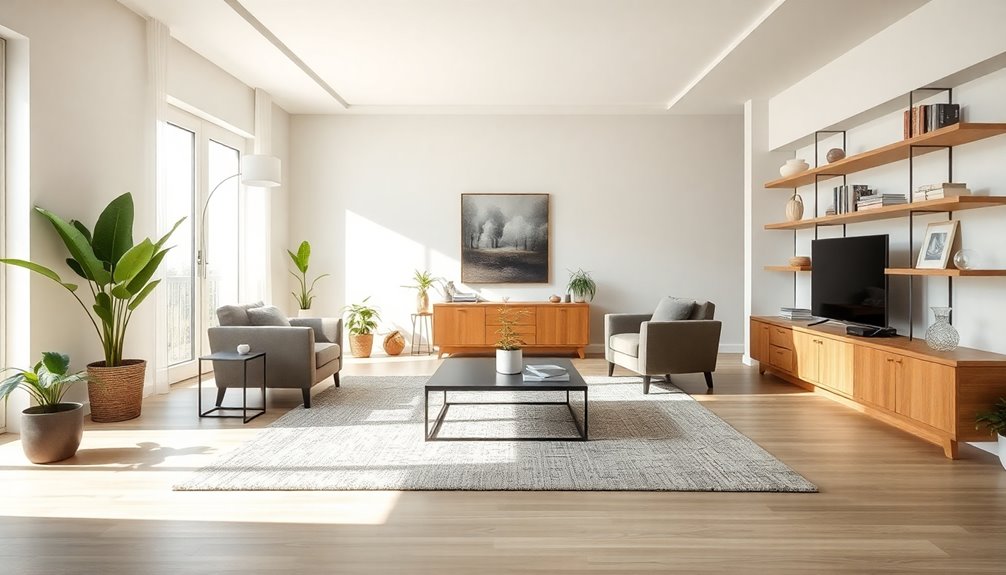
After ensuring your furniture adapts to your needs, the next step is to create clutter-free pathways throughout your home.
Clear pathways enhance mobility and greatly reduce the risk of falls, making it easier for you to age in place comfortably. Aim for a minimum width of 36 inches for these pathways to accommodate walkers and wheelchairs.
Strategically arranging your furniture and removing unnecessary items will open up your space, improving both safety and aesthetics.
Regularly decluttering and organizing your living areas can help maintain this environment, as clutter can lead to confusion and accidents.
Consider using storage solutions like baskets and bins to keep frequently used items accessible without obstructing your pathways. Additionally, investing in best home security systems can provide peace of mind by ensuring a safe environment as you navigate your home.
Incorporate Smart Home Technology
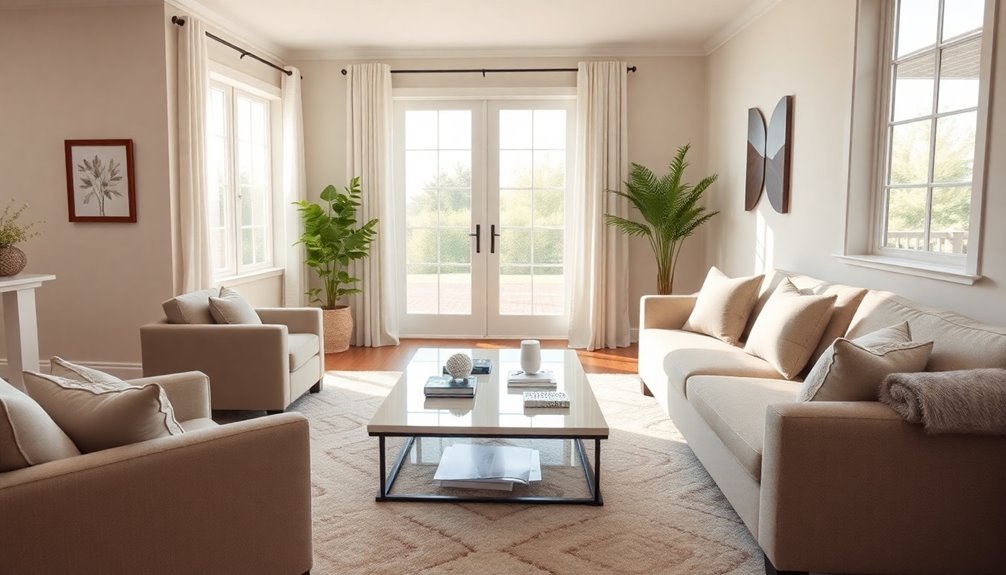
Smart home technology offers an array of solutions that can greatly enhance safety and convenience for seniors aging in place.
With these innovations, you can live independently while promoting your health and happiness:
- Voice-Activated Assistants: Use devices like Amazon Alexa or Google Assistant to control lights, locks, and appliances hands-free.
- Motion Sensors: These alert caregivers of inactivity, providing peace of mind and enhancing safety.
- Health Monitoring Devices: Smartwatches and health apps track your essential signs, notifying caregivers of significant changes.
Ensure Accessible Kitchen Design
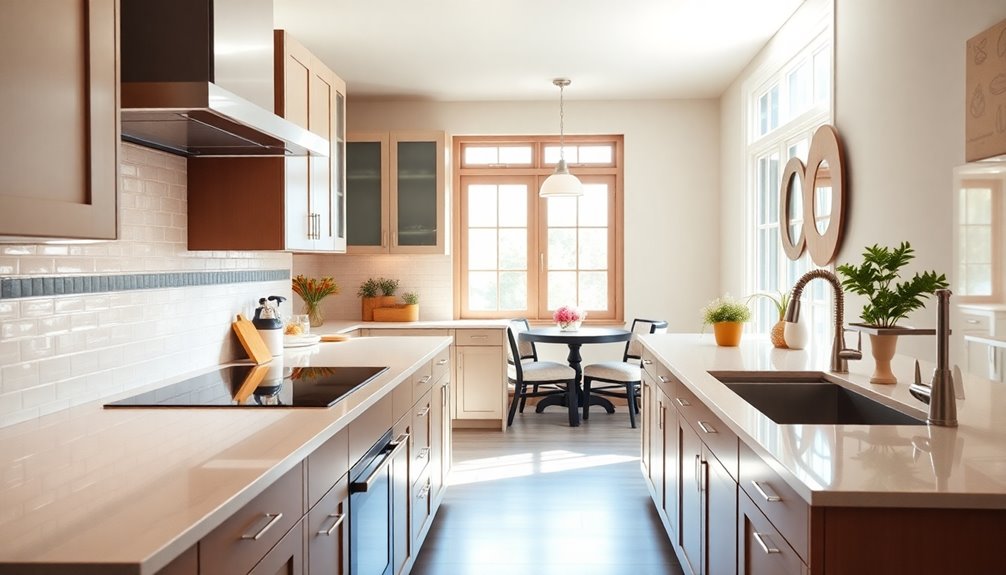
When designing your kitchen for accessibility, focus on ergonomic workstation heights that make meal prep comfortable.
Non-slip flooring options can prevent accidents, while accessible storage solutions keep everything within reach.
These changes not only enhance safety but also promote independence in your daily cooking routine. Additionally, consider incorporating energy-efficient appliances that can help reduce overall energy consumption while offering convenience.
Ergonomic Workstation Heights
Creating an accessible kitchen design means ensuring ergonomic workstation heights that cater to everyone's needs. For ideal comfort and ease of use, consider these key features:
- Countertop Height: Set between 28 to 34 inches to accommodate various heights and mobility needs, making food prep easier for everyone.
- Sink Position: Aim for a height of 30 to 32 inches, with enough legroom underneath for wheelchair users to access comfortably.
- Storage Solutions: Install pull-out shelves and drawers at reachable heights to reduce bending and strain on joints.
Incorporating these ergonomic workstation heights not only promotes independence but also supports aging individuals in maintaining a functional and enjoyable kitchen environment. Additionally, considering local building codes ensures that modifications meet safety standards and improve overall accessibility.
Non-Slip Flooring Options
To enhance safety in your kitchen, choosing the right non-slip flooring is essential, especially for seniors.
Consider non-slip flooring options like cork, rubber, or linoleum to greatly reduce the risk of slips and falls. These materials provide a textured surface that helps in maintaining traction.
Additionally, placing anti-fatigue mats with beveled edges in frequently used areas can offer cushioning while minimizing trip risks. Make sure your flooring is smooth and level to facilitate easy navigation.
Incorporating contrasting colors at changes can signal alterations in elevation, enhancing visibility and depth perception.
Avoid shiny surfaces and strong patterns in your kitchen flooring to further improve safety for seniors, as these features can create confusion and hinder movement.
Accessible Storage Solutions
Accessible storage solutions are essential for an age-friendly kitchen design, ensuring that seniors can navigate their space with ease.
Here are three effective strategies to evaluate:
- Pull-out shelves and drawers in lower cabinets allow easy access without excessive bending or reaching.
- Accessible refrigerators with storage inside the door simplify access to frequently used items, accommodating those with limited mobility.
- D-shaped cabinet pulls instead of knobs provide an ergonomic grip, making it easier to open cabinets and drawers comfortably.
Design a Safe Bathroom Environment
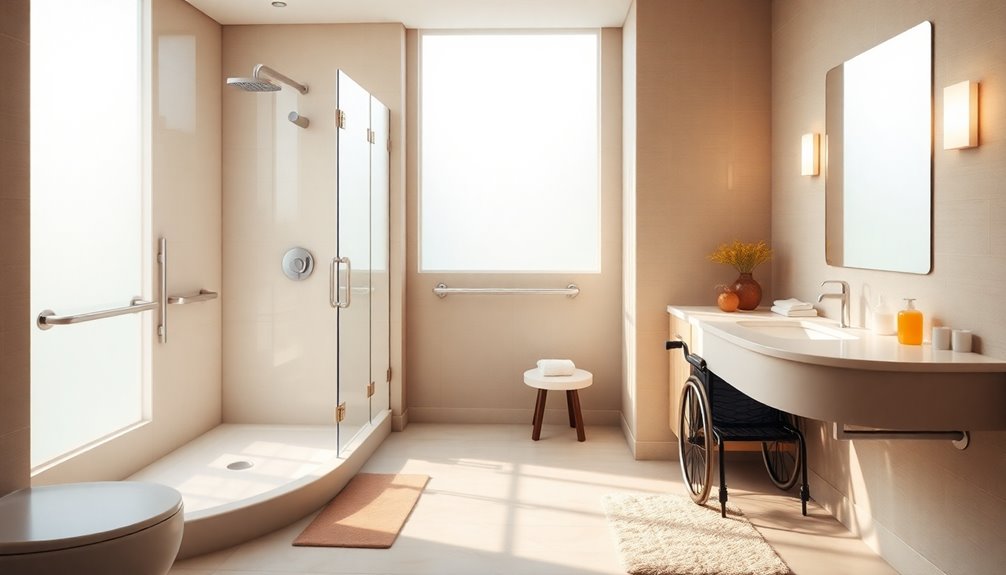
When designing a safe bathroom environment for seniors, it's vital to prioritize features that enhance both comfort and stability.
Installing walk-in showers eliminates the need to step over bathtubs, greatly reducing the risk of falls. Adding grab bars near toilets and in the shower provides stable support, helping seniors maintain balance.
Consider utilizing shower seats and handheld showerheads for safer, more comfortable bathing experiences, accommodating varying mobility levels.
Implementing non-slip mats and textured flooring is essential to prevent slips and falls, contributing to a safer bathroom environment.
Finally, adjusting toilet height with a seat extender can greatly improve accessibility, making it easier for seniors to sit and stand without strain.
Your efforts can create a truly safe sanctuary.
Plan for Future Mobility Needs
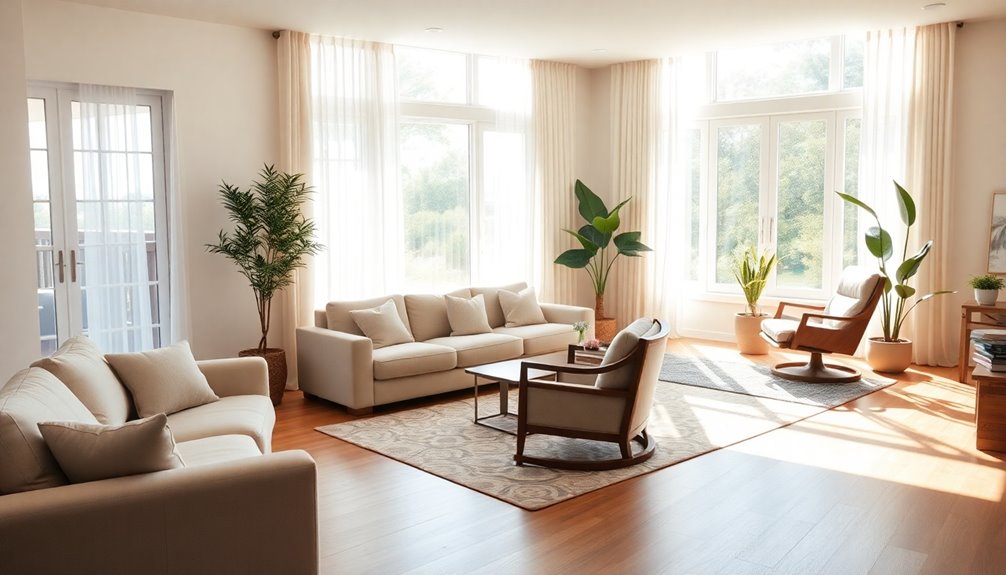
As you plan for future mobility needs, it's vital to create a living space that adapts to changing physical abilities. By prioritizing accessibility and safety, you can guarantee your home remains comfortable and functional.
Consider the following:
- Open floor plans with no-step entries and wider doorways (at least 36 inches) to accommodate walkers and wheelchairs.
- Install grab bars in key areas like bathrooms and near seating for essential support as mobility decreases.
- Incorporate adjustable-height features in beds and kitchen counters to accommodate varying physical abilities.
Additionally, guarantee bright, well-distributed lighting to help prevent falls and facilitate navigation.
With these thoughtful adjustments, your home can evolve with your mobility needs, promoting independence and comfort.
Frequently Asked Questions
What Is the Best Home Design for Aging in Place?
When you think about the best home design for aging in place, you might worry that it'll lack style. But it doesn't have to!
An open floor plan with minimal obstructions and wider doorways makes movement easier. Adding grab bars and adjustable-height fixtures guarantees comfort and safety. Incorporating smart technology can enhance your independence.
How to Build a House to Age in Place?
To build a house to age in place, start by incorporating an open floor plan that offers wider doorways and no-step entries for easy navigation.
Design bathrooms with walk-in showers and grab bars to enhance safety.
In the kitchen, use adjustable-height features and hands-free faucets for convenience.
Opt for soft flooring to minimize joint discomfort.
Finally, plan for future needs by considering ramps and other accessibility options to adapt as health concerns arise.
What Is a Universal Design for Aging in Place?
You might think universal design is just for the elderly, but it's really for everyone.
Universal design for aging in place creates spaces that accommodate all ages and abilities, ensuring ease of movement and safety.
Features like wider doorways, lever-style handles, and non-slip flooring enhance usability, making your home accessible without sacrificing style.
What Is Aging in Place in Interior Design?
Aging in place in interior design means creating a home environment that allows you to live independently and safely as you age.
It involves making modifications to accommodate your changing needs, like wider doorways and no-step entries.
You'll want features like grab bars and non-slip flooring to prevent falls, along with improved lighting and accessible furniture.
This approach guarantees your home remains functional and comfortable, supporting your lifestyle over time.
Conclusion
Creating a home that’s perfect for aging in place isn’t just a smart choice; it’s like crafting your own personal sanctuary for the golden years! By embracing these design tricks, you can transform your space into a haven of comfort and safety. With thoughtful adjustments, you’ll not only enhance your quality of life but also guarantee that your home remains a joyful retreat for years to come. So, start implementing these ideas today and watch your living space flourish! To ensure that your sanctuary truly meets your needs, consider integrating cozy interior design tips for seniors that promote both functionality and ease of movement. Simple changes, such as adding non-slip mats, improving lighting, and choosing easy-to-use fixtures, can make a world of difference. Remember, your home should not only reflect your personal style but also support your lifestyle, allowing you to enjoy every moment in comfort and security.
